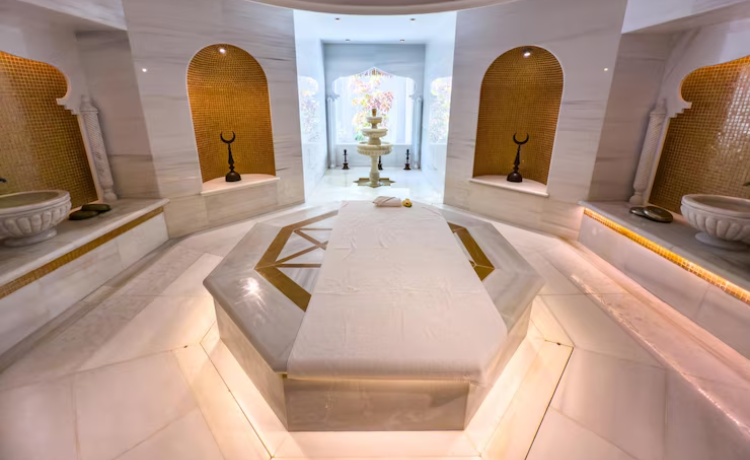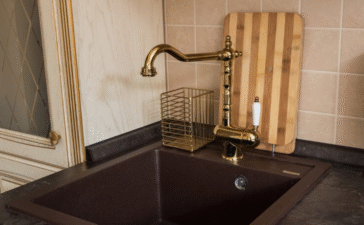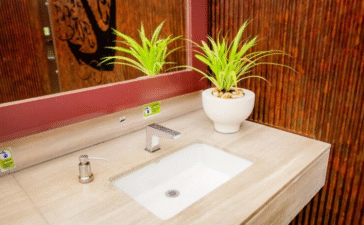The allure of Turkish baths goes far beyond their stunning marble surfaces and intricate mosaics. These sacred spaces epitomise a centuries-old wellness tradition that combines therapeutic bathing rituals with architectural masterpieces and captivates visitors from all over the world. Turkish baths, also known as hamams, have evolved from ancient Roman and Byzantine bathing traditions into unique Turkish cultural institutions that continue to influence modern spa and bath design today.
The growing fascination with Turkish-inspired baths in modern homes reflects our collective desire for wellness-orientated living spaces. As more and more people seek to transform their daily routines into mindful rituals, the principles of Turkish bathroom design provide a perfect blueprint for creating luxurious, health-orientated environments at home.
Understanding Turkish bath culture will give you an insight into a tradition that masterfully harmonises physical cleansing and spiritual renewal. The hammam experience encompasses far more than just personal hygiene it represents a holistic approach to wellness that modern bathroom design is increasingly trying to emulate.
The Historical and Cultural Significance of Turkish Bathrooms
What is a Turkish Bathroom?
Turkish baths and hamams represent the pinnacle of the bathing culture that developed over centuries in the Ottoman Empire. These architectural marvels serve as cornerstones where traditional Turkish bathing experiences unfold through carefully orchestrated rituals of cleansing, relaxation and social interaction.
Historic hamams were created from the fusion of Roman thermal baths, Byzantine baths and Islamic purification traditions. This unique combination created spaces that went beyond pure functionality and became an integral part of community life. The development of Turkish baths reflects the highly developed understanding of wellness that characterised Ottoman society.
The cultural significance of the hamams goes beyond individual cleansing practises. These spaces acted as equalisers where people from all social classes came together and shared the universal human need for cleansing and renewal. The democratic nature of the Turkish baths contributed to their enduring appeal and cultural significance.
The Role of Turkish Bathrooms in Daily Life
Turkish bath rituals transformed everyday cleansing into spiritual and social experiences that strengthened community bonds. The hamam served as more than a bathing facility—it functioned as a neighborhood hub where people gathered to share news, conduct business, and maintain social connections.
The community aspect of hamams created unique social dynamics that influenced Turkish culture for generations. Women often used hamam visits as opportunities for matchmaking, celebrating special occasions, and conducting intimate conversations away from male relatives. Men similarly utilized these spaces for business discussions and social networking.
The social importance of Turkish baths manifested in elaborate ceremonies surrounding life events. Weddings, births, and religious celebrations often included special hamam visits that reinforced community ties and cultural traditions. These ritualistic gatherings elevated the simple act of bathing into meaningful cultural experiences that bound communities together.
Creating a Turkish-Inspired Bathroom at Home
Design Elements of a Traditional Turkish Bathroom
Turkish bathroom design prioritizes natural materials that create serene, spa-like environments conducive to relaxation and reflection. Marble tiles form the foundation of authentic Turkish-style bathrooms, providing both practical benefits and aesthetic appeal that defines the hamam experience.
The selection of marble for Turkish bathrooms goes beyond mere decoration—these natural stones offer thermal properties that enhance the bathing experience. Marble’s ability to retain and gradually release heat creates the warm environment essential for traditional Turkish bath rituals. The variety of marble patterns and colors available allows for personalized interpretations while maintaining authentic appeal.
Mosaic design elements add intricate beauty that transforms functional spaces into artistic environments. Traditional Turkish mosaics incorporate geometric patterns and floral motifs that reflect Islamic artistic traditions. These detailed decorative elements create focal points that elevate the overall bathroom aesthetic while honoring cultural heritage.
Luxurious bathroom aesthetics in Turkish design emphasize the interplay between light and shadow, created through strategic placement of windows, skylights, and artificial lighting. The domed ceilings characteristic of traditional hamams maximize natural light distribution while creating the sense of expansive space that enhances relaxation.
Key Accessories to Complete the Look
Turkish towels, crafted from premium cotton grown in the Aegean region, offer superior absorbency and quick-drying properties that make them ideal for bathroom use. These traditional textiles, known for their flat weave construction, provide the authentic touch necessary for recreating the hamam experience at home.
The kese mitt represents an essential Turkish bath accessory designed for the exfoliation rituals central to hamam culture. These specially woven mitts remove dead skin cells more effectively than conventional washcloths, revealing smoother, healthier skin beneath. Incorporating kese mitts into home bathing routines allows for authentic Turkish bath experiences.
Turkish bath accessories extend beyond textiles to include specialized soaps and cleansing products. Olive oil soaps, traditionally made with pure olive oil and natural ingredients, provide gentle yet effective cleansing that complements the Turkish bathing philosophy. These natural products align with the holistic wellness approach that defines hamam culture.
Peştamal, the traditional Turkish bath wrap, serves both functional and aesthetic purposes in authentic Turkish bathroom settings. These lightweight, quick-drying cloths offer modesty and comfort during bathing rituals while adding authentic cultural elements to modern bathroom spaces.
The Health and Wellness Benefits of a Turkish Bathroom
Relaxation and Stress Relief
Turkish bath health benefits encompass both immediate relaxation effects and long-term wellness improvements that result from regular practice of traditional bathing rituals. The combination of heat, humidity, and specialized treatments creates optimal conditions for deep muscle relaxation and mental stress relief.
Steam bath therapy, fundamental to the Turkish bathing experience, promotes cardiovascular health through controlled heat exposure that increases circulation and heart rate. This gentle cardiovascular stimulation provides exercise-like benefits while encouraging deep relaxation that counteracts daily stress accumulation.
The relaxation benefits of Turkish baths extend beyond physical comfort to include measurable improvements in sleep quality and mental clarity. Regular hamam visits or home Turkish bath experiences can reduce cortisol levels and promote the release of endorphins that enhance overall well-being and emotional balance.
Exfoliation in Turkish baths removes dead skin cells and stimulates circulation, resulting in improved skin texture and appearance. The thorough cleansing achieved through traditional kese mitt treatments surpasses conventional bathing methods, providing deeper purification that leaves skin feeling rejuvenated and refreshed.
Detoxification and Skin Rejuvenation
The detoxifying bath experience provided by Turkish bathrooms facilitates the elimination of toxins through increased perspiration and improved circulation. The heat and humidity characteristic of hamam environments encourage the body’s natural detoxification processes while providing relaxation benefits that support overall health.
Skin rejuvenation through Turkish bath practices occurs through multiple mechanisms including increased blood flow, deep cleansing, and natural moisturization. The combination of heat, exfoliation, and traditional treatments creates optimal conditions for cellular renewal and improved skin health.
Turkish bath for skin improvement relies on time-tested techniques that utilize natural ingredients and gentle treatments to enhance skin appearance and texture. The gradual warming process opens pores and prepares skin for deep cleansing, while subsequent treatments nourish and protect newly revealed skin surfaces.
Natural Turkish soap, typically made with olive oil and other plant-based ingredients, provides gentle yet effective cleansing that maintains skin’s natural moisture balance. These traditional soaps avoid harsh chemicals that can disrupt skin health, instead relying on natural ingredients that support the skin’s protective barrier function.
Exploring Famous Hamams and Turkish Bathing Culture
Renowned Hamams in Turkey
Famous Turkish baths throughout Turkey showcase the architectural mastery and cultural significance of hamam design. Cagaloglu Hamami in Istanbul, established in 1741, represents one of the oldest and most prestigious Turkish baths still in operation today. This historical landmark demonstrates the enduring appeal of traditional Turkish bathing culture.
Hurrem Sultan Hamami, named after the beloved wife of Sultan Suleiman the Magnificent, exemplifies the luxury and sophistication associated with Ottoman-era bathhouses. This Istanbul hamam combines historical significance with contemporary amenities, providing visitors with authentic experiences that honor traditional practices while meeting modern comfort expectations.
The architectural features of these Istanbul hamams reflect centuries of refinement in Turkish bathroom design. Domed ceilings, intricate marble work, and carefully planned layouts create environments that facilitate both individual relaxation and social interaction. These design elements continue to influence contemporary Turkish-inspired bathroom projects worldwide.
Experiencing a Turkish Bath: A Step-by-Step Guide
The Turkish bath experience follows time-honored protocols that maximize both health benefits and cultural authenticity. Understanding hamam etiquette ensures respectful participation in these traditional practices while enhancing personal enjoyment of the experience.
Visitors preparing for hamam visits should understand the progression from warming rooms to hot rooms, followed by cooling and relaxation periods. This graduated approach allows the body to adjust gradually to temperature changes while maximizing the therapeutic benefits of heat therapy.
Turkish bath traditions include specific rituals surrounding exfoliation, massage, and relaxation that have been perfected over centuries. Professional hamam attendants guide visitors through these processes, ensuring safe and effective treatment while maintaining cultural authenticity.
How to visit a hamam involves practical considerations including appropriate timing, what to bring, and understanding service options. Most hamams provide necessary items including peştamal and basic toiletries, though visitors may prefer to bring personal items for comfort and hygiene preferences.
Modern Adaptations of Turkish Bathrooms
Incorporating Turkish Style into Your Bathroom
Modern Turkish bathroom design successfully integrates traditional hamam elements with contemporary amenities and technologies. This fusion approach allows homeowners to experience Turkish bathing culture while enjoying modern conveniences including temperature control, efficient plumbing, and energy-saving features.
Turkish-style bathroom renovation projects require careful planning to balance authentic design elements with practical modern requirements. Steam showers can replicate hamam conditions while fitting into standard residential spaces. Heated floors provide comfort that mirrors the warm marble surfaces found in traditional Turkish baths.
Contemporary adaptations of Turkish bathroom design often incorporate smart technology that enhances the traditional experience. Programmable steam systems, chromotherapy lighting, and integrated sound systems can create personalized hamam experiences that adapt to individual preferences and schedules.
Energy-efficient bathroom features increasingly complement Turkish design elements without compromising authenticity. LED lighting systems can recreate the soft, warm illumination characteristic of traditional hamams while reducing energy consumption and maintenance requirements.
Sustainable and Eco-Friendly Bathroom Choices
Eco-friendly Turkish bathroom design incorporates environmentally responsible materials and practices while maintaining the luxury and wellness benefits associated with traditional hamam experiences. Sustainable material choices include reclaimed marble, recycled glass mosaics, and low-impact construction methods.
Sustainable bath accessories complement environmentally conscious Turkish bathroom design through the selection of organic cotton textiles, naturally made soaps, and biodegradable cleaning products. These choices align with the natural, health-focused philosophy underlying Turkish bathing traditions.
Green bathroom design principles can enhance Turkish-inspired spaces through water-efficient fixtures, natural ventilation systems, and renewable energy integration. Solar water heating systems, for example, can provide the consistent hot water supply essential for authentic Turkish bath experiences while reducing environmental impact.
The integration of living elements such as plants and natural air purification systems supports both environmental goals and the wellness philosophy central to Turkish bathroom culture. These features create healthier indoor environments while honoring the connection with nature that characterizes traditional hamam design.
The Timeless Appeal of Turkish Bathrooms
The enduring popularity of Turkish-inspired bathrooms reflects our general desire for spaces that promote both physical and mental wellbeing. At a time when modern life is becoming increasingly fast-paced and stressful, the principles underpinning Turkish bathroom design offer valuable solutions for creating restorative living environments.
The appeal of Turkish bathrooms transcends cultural boundaries, as these spaces address the basic human needs for cleansing, relaxation and renewal. The holistic approach to wellness that hammam culture embodies provides a template for designing bathrooms that support both daily routines and long-term health goals.
Luxury bathroom design is increasingly taking inspiration from Turkish traditions because these time-honoured approaches successfully combine aesthetics, functionality and wellness benefits. The sophisticated understanding of human comfort and health that is evident in traditional hamam design is also being incorporated into modern bathroom design and construction.
The wellness bathing culture, characterised by Turkish traditions, offers valuable insights for anyone looking to transform their daily routines into meaningful self-care practises. By understanding and implementing the principles of Turkish bathroom design, you can create spaces that promote both individual wellbeing and family health.
Turkish-inspired bathroom design is an investment in long-term wellbeing that pays dividends through improved daily experiences and a higher quality of life. The therapeutic benefits of incorporating Turkish bathing principles into the design of your home go far beyond aesthetic appeal and include measurable improvements in physical and mental health.
Whether through a complete bathroom renovation or simple additions of Turkish bath accessories, the timeless wisdom of hamam culture offers practical solutions to modern wellness challenges. The Turkish bath at home offers opportunities for stress relief, skin care and personal renewal that promote overall health and satisfaction.
You would also like: “Board and Batten Bathroom“
Frequently Asked Questions
What makes a Turkish bathroom unique?
Turkish bathrooms distinguish themselves through their emphasis on communal wellness rituals, specialized architectural features like domed ceilings and marble construction, and the integration of therapeutic treatments into daily cleansing routines. The hamam experience combines physical purification with social interaction and spiritual renewal, creating a holistic approach to personal care that differs significantly from conventional bathroom design.
What materials are used in traditional Turkish bathrooms?
Traditional Turkish bathrooms primarily utilize natural marble for flooring and wall surfaces, chosen for its thermal properties and durability. Complementary materials include ceramic and glass mosaics for decorative elements, copper fixtures for water systems, and natural stone for architectural details. These materials work together to create the warm, humid environment essential for authentic Turkish bath experiences.
How do I recreate the Turkish bath experience at home?
Recreating the Turkish bath experience requires incorporating key elements including steam generation through shower systems or saunas, natural materials like marble tiles, traditional accessories such as kese mitts and olive oil soaps, and appropriate lighting that creates a serene atmosphere. The experience also involves adopting Turkish bathing rituals including gradual warming, thorough exfoliation, and extended relaxation periods.












